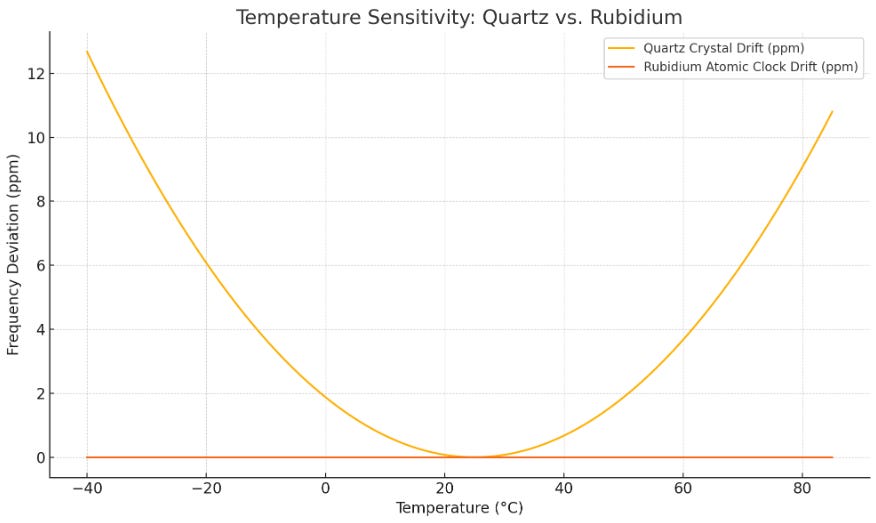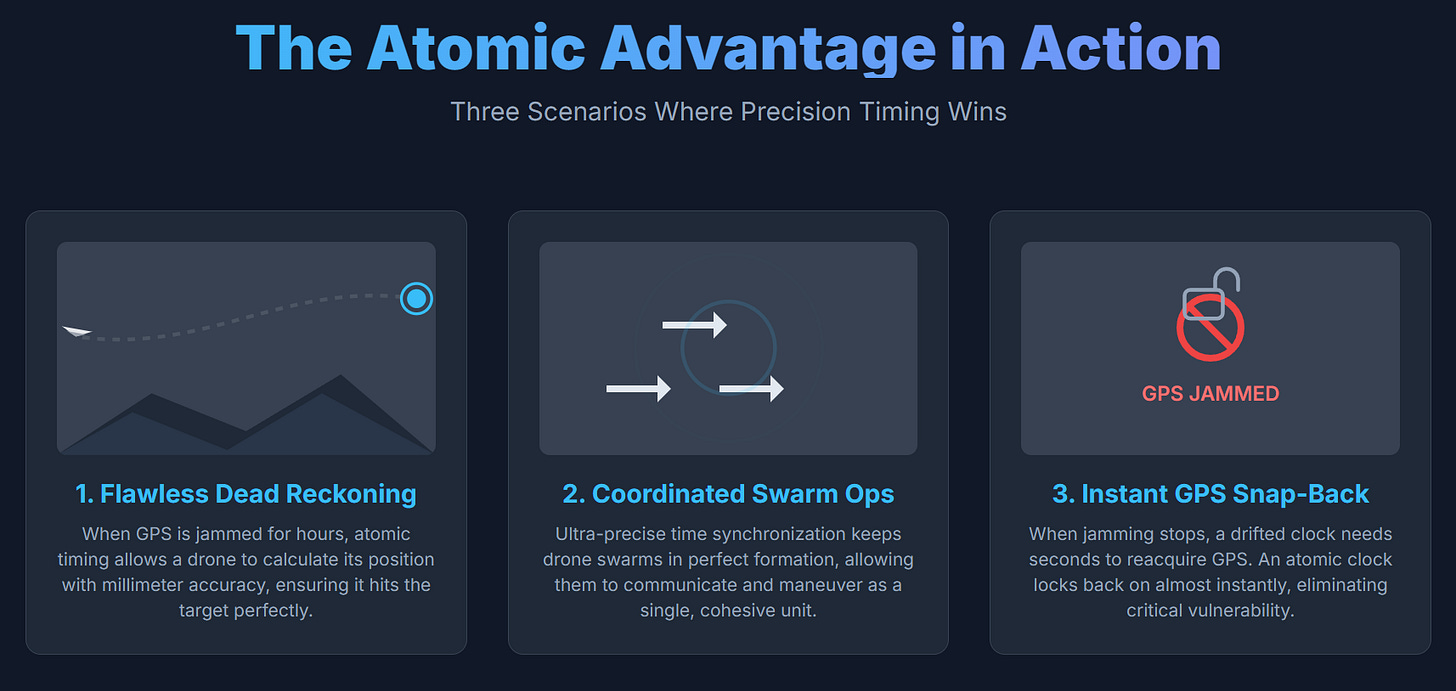Why Tiny Atomic Clocks Could Decide Tomorrow's Drone Wars — and Put Frequency Electronics (FEIM) on Investors' Radar
Picture this: A Ukrainian drone operator stares at his suddenly blank screen. Russian EW trucks just killed his GPS link to a $2 million recon bird that's still 500 clicks from home. Now he's navigating by "that weird church" and river bends — and yes, that's actually how they do it. Welcome to modern warfare, where your ability to keep perfect time might matter more than your ammunition count.
This scenario plays out constantly across Ukraine's electromagnetic battlefield. And it's exactly why a 55-year-old company that makes atomic clocks is suddenly very interesting to both Pentagon brass and anyone hunting for mispriced tech stocks.
Your Phone Checks the Time. Everything Else Depends on It.
Here's something most people don't realize: every single digital transaction in modern life — every stock trade, every cell tower handoff, every GPS calculation — lives or dies by nanosecond-precision timing. The quartz crystal in your phone drifts about 10 parts per million. That's roughly a second per day, which was totally fine when all you did was scroll Instagram.
But throw that same timing accuracy into a drone trying to dead-reckon through 10 hours of GPS jamming? You've got a very expensive lawn dart.
Meet the Company That Makes Time Stand Still
Frequency Electronics (NASDAQ: FEIM) isn't exactly a household name, but NASA's been trusting them to navigate billion-dollar space probes since before your parents met. The company just posted $69.8 million in fiscal 2025 revenue — best numbers they've seen in 25 years. Satellites still pay most of the bills at 60% of sales, but here's where it gets interesting.
Their new product is called TURbO™. It's a rubidium atomic clock they've somehow crammed into a soda can. More importantly, they've ruggedized it for modern drone warfare.
Quick physics lesson, and I promise this matters for the investment case: Quartz crystals work like tiny tuning forks — they vibrate at a specific frequency. Problem is, everything affects that vibration. Heat? Vibrates faster. Cold? Slower. Drop it? Good luck. Rubidium atomic clocks? They watch electrons jump between energy states in rubidium atoms. This is quantum mechanics territory — the universe itself is your metronome. Temperature, shock, age... none of it matters when you're measuring against the fundamental constants of physics.
The numbers are absurd: TURbO hits ≤1 × 10⁻¹¹ stability. In English? That's 0.1 microseconds drift per day. Put another way, this clock would lose one second every 3,000 years. For our hypothetical Ukrainian drone, that's the difference between threading the needle through a specific window versus missing the entire neighborhood.
Why Drone Jocks Are Obsessed with Atomic Time
I've been digging through Ukrainian operator posts, and the situation is worse than most people realize. Russian EW can blank out GPS "for hours at a time." Pilots literally navigate by landmarks — "turn left at the burned tank, follow the river until you see the collapsed bridge." It's World War I navigation in a Fifth Generation war.
Here's where atomic timing completely changes the game, in three very specific ways:
Dead Reckoning That Actually Works When GPS dies, you're down to basic math: last known position plus speed and direction equals... hopefully where you think you are. Standard quartz timing drifts about 1 second daily. For a drone cruising at 100 km/h over 10 hours, that's 10 meters of position error. Not terrible, until you realize you're trying to fly through a specific valley to avoid radar. Rubidium's 0.1 microsecond drift? Your position error is 0.01 millimeters. Yeah, millimeters. You could fly blind for a week and still hit your target.
Swarm Ops Without the Chaos Modern drone swarms share radio spectrum using time slots — think of it like everyone taking turns talking, but the turns are milliseconds long. Quartz clocks drift apart within hours, creating a mess of overlapping transmissions. It's like twenty people trying to use the same walkie-talkie channel. Rubidium keeps everyone synced to within 20 nanoseconds. Your 20-drone swarm stays tight as a drum, even after flying all day.
GPS Snap-Back Here's a nasty little secret: when jamming stops, drifted clocks need several seconds to reacquire GPS. In contested airspace, three seconds might as well be three hours. Rubidium-timed systems lock back on in under 200 milliseconds. Blink and you're back online.
Show Me the Money: Why Wall Street's Missing the Boat
Alright, let's talk valuations, because this is where things get genuinely weird. FEIM just posted 26% revenue growth. The average aerospace supplier? Lucky to hit 8%. The company's sitting on $70 million in backlog — basically a year of revenue already locked in. And yet...
Look at these multiples. Just look at them:
FEIM trades at one-sixth of SiTime's multiple. One. Sixth. And here's the kicker — any decent semiconductor fab can pump out MEMS oscillators like SiTime makes. But space-qualified rubidium atomic clocks? Maybe a dozen companies on Earth have that expertise. We're talking decades of experience in quantum physics, vacuum systems, and making electronics that won't fry in radiation. This isn't something you just decide to start making.
Even Honeywell — boring, diversified, 6% growth Honeywell — gets a richer multiple than FEIM. The market is literally valuing bleeding-edge atomic timing technology like it's a metal-bending shop in Cleveland. If FEIM just got Honeywell's multiple (forget about SiTime's nosebleed valuation), that's an instant 16% pop. Before any growth.
The balance sheet's clean as a whistle too. Basically no debt, cash coming in from recent profitability, plenty of runway to scale TURbO production without begging Wall Street for money. Management said on the July 11 call that production revenue should hit "near term," with $20 million annually from drones alone by FY2027. And that's just one market.
Five Ways This Gets Huge
The drone opportunity is obvious, but it's actually just the appetizer. Here's what could really move the needle:
Pentagon Goes Shopping The Replicator initiative wants thousands of autonomous systems by 2026. Not hundreds. Thousands. Every single one needs timing good enough to fight through jamming. Ukraine just proved that quantity only beats quality when quantity can navigate.
50,000 Satellites Walk into a Bar... SpaceX, Amazon, the Chinese — everyone's throwing satellites up like confetti. We're talking 50,000+ birds this decade. Each one needs atomic timing for laser links between satellites. These aren't your grandfather's GEO satellites either. LEO constellations need compact, power-sipping timing. Sounds familiar?
Quantum Navigation (Yeah, It's Real) Defense contractors are building sensors that navigate by measuring tiny changes in gravity. No GPS, no signals, no nothing. Just pure physics. Guess what these quantum sensors need to work? Ultra-stable timing references. FEIM's already shipping to quantum labs.
5G's Dirty Little Secret Real 5G (not the marketing BS your carrier's pushing) needs base stations synchronized to ±1.5 microseconds. When the fiber backhaul fails, towers need holdover timing. There are 5 million cell sites globally. Do the math.
M&A Bait Microchip, Safran, even Honeywell — they'd all love FEIM's space credentials. At under $200 million market cap, FEIM's a rounding error for these giants. One press release and boom, 50% premium.
Reality Check: What Could Go Wrong
I'm bullish, but I'm not stupid.
Customer concentration is real. NASA, Space Force, and maybe three primes drive 60%+ of revenue. One delayed contract, one budget sequester, and quarterly numbers go sideways fast. Though honestly, with SpaceX and others ramping, this problem might solve itself.
This is a true micro-cap. We're talking 15,000 shares average daily volume. One hedge fund having a bad day could crater the price. Or send it to the moon. If you need to get out fast, this isn't your stock.
TURbO's still moving from lab to production floor. Aerospace customers are conservative as hell — qualification cycles could stretch longer than management expects. Though given how conservative these guys have been historically, I'm inclined to believe their "near term" guidance.
Bottom Line: The Clock's Ticking on This Opportunity
Here's what it comes down to. Autonomous systems are exploding across every domain — land, sea, air, space. Every single one needs an electronic heartbeat that doesn't skip. Frequency Electronics makes that heartbeat, has been making it for NASA for longer than most investors have been alive, and somehow trades like a value trap.
Next time you see headlines about drone swarms or satellite constellations, remember they're all dependent on insanely precise timing. At today's prices, you can own the company that makes that timing for industrial multiples. In a world where milliseconds determine mission success and market share, that feels like the kind of asymmetric bet that doesn't come along often.
Peter Lynch used to say the best investments are boring companies doing essential things. Well, atomic clocks are about as boring as it gets. Until you realize they're the invisible infrastructure enabling a trillion-dollar transformation in how we fight, communicate, and navigate.
At 3.37x sales, the market clearly hasn't figured this out yet.











